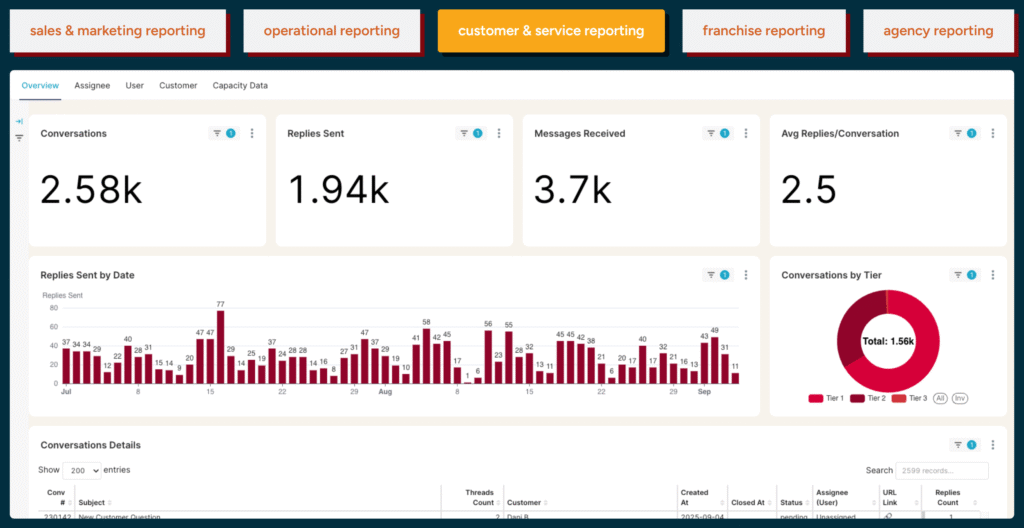The Support Capacity Formula That Tells Me When to Hire or When to Fix the Product
Knowing support capacity isn’t about costs; it’s about clarity. Here’s the formula we use to decide when to hire and when to fix the product.
Editor’s Note: This article was first published on my site in an earlier form. It has been fully updated with new insights, examples, and resources to reflect how we use this formula today.
If you’ve ever felt the pressure of an overflowing support inbox, you know the frustration: late replies, stressed teammates, and customers slipping away. The question nags at every product leader: should you hire more people or fix the product that’s driving the volume? This article gives you a proven formula to answer that question with confidence.
Support teams often decide to hire based on feelings. They wait until the inbox is overflowing and then rush to bring someone on board. I’ve done it too. The result is clear: the team can burn out from too many tickets, or payroll can swell with unnecessary staff.
I email once a week about my writings, it’s unique content you won’t get anywhere else, and I reply to every email I receive from those emails. If you’d like to hear more from me, subscribe here and let’s chat about how you can be more successful in your WordPress product business.
Subscribe
I first created this formula when we were scaling the GiveWP support team. Later, once GiveWP joined StellarWP, I was able to apply the same framework across all StellarWP brands. That experience proved that this approach works for any WordPress product support team, not just one company.
For fast-growing product companies, this guesswork is riskier. Growth brings many new users and questions. Without a clear system, support costs can increase sharply. We found that the issue wasn’t the budget. We lacked a reliable way to measure capacity. Once we began tracking it, hiring shifted from guessing to smart scaling.
How to Measure Support Capacity
We created a simple formula with two factors: the minutes our tickets need and the minutes our agents have.
- Minutes Needed = ticket load × average handle time.
- Minutes Available = team size (FTEs) × working minutes per week.
- Capacity Ratio = minutes needed ÷ minutes available.
- Compound Capacity = a view that combines current demand with backlog over time.
The ratio tells us what’s happening. A score above 1 means we’re overwhelmed. Customers wait longer, quality drops, and the backlog grows. A score of 0.5–0.7 indicates that the team maintains a healthy balance by being engaged but not strained. By tracking compound capacity, we can spot long-term strain before it becomes a crisis. For a fast-growing product business, this early warning is crucial. It shows if growth is sustainable with the current team or if adjustments are needed.
Download the Capacity Sheet
I’m not the only one who finds this framework useful. I teamed up with the BlinkMetrics crew. They added a “Capacity Data” tab to their analytics platform using my spreadsheet. This showed me that our formula is practical enough for enterprise reporting.

Want to see how these numbers work in real life? I created a sample capacity sheet based on the formula. You can download it for free by joining my email list.
Plug in your own ticket load, handle time, and staffing levels to see your team’s real capacity week by week. This tool is especially helpful for product shops in high-growth phases. It helps prevent small support issues from becoming large ones.
Special Offer from BlinkMetrics
The BlinkMetrics team can help you automate this capacity sheet – and a ton more. BlinkMetrics builds custom reporting dashboards for you, so you can scale your operations.
For a limited time, book a call with them and just mention that you read this article of mine and they’ll give you 50% off your first 6 months with them! They’ll even cover all the setup time to get you up and running with a fully automated Capacity Sheet along with other reporting like integrated revenue reporting, traffic to documentation guides!
I think that’s an amazing deal for the right business, so if you need automated reports across multiple APIs, you should book a call with Nathan and team at BlinkMetrics.
(full disclosure: I am not an affiliate, I don’t get a cut of anything, I just asked them if they’d offer my audience a deal and WOW! A great deal!)
What capacity numbers reveal about your next move
Capacity isn’t for deciding when to hire. It helps you find the real problem.
If your capacity is over 90% on a regular basis, you need more staff. But if your ratio is healthy and your support costs are still high, the issue isn’t headcount; it’s volume. Too many tickets may come from the product itself.
This shifts the conversation. Instead of asking, “Who should we hire?” you ask, “Why are customers contacting us so much?” For businesses that are scaling quickly, this question is vital. It can mean the difference between compounding growth and costs.
Using capacity to guide decisions
When numbers show you’re staffed well but costs are high, the focus shifts to ticket prevention. Look upstream:
- Onboarding: Does your initial experience clear up confusion or create it?
- Documentation: Are common questions answered clearly, or do they lead customers to support?
- Product fixes: Which repeated issues could be solved with product changes?
Capacity metrics force these questions. They show when the bottleneck is the product, not the people. For fast-growing product shops, this distinction protects margins and helps new users succeed.
Turning Capacity into a Growth Lever
Capacity turns support from a vague department into a measurable system. Once you know your ratio, you won’t wonder if you need to hire, freeze, or invest in product. The numbers will guide you.
Here’s how to apply it:
- Track closed tickets, handle time, and team minutes weekly.
- Calculate your capacity ratio: minutes needed ÷ minutes available.
- What I call “Compound Capacity” takes into account tickets that weren’t resolved in previous weeks. Monitor this for long-term trends.
- Act on the numbers: hire if you’re overloaded. Hold steady if you’re balanced. Fix the product if costs are high but without adding more work.
For growing product companies, this process is a safeguard. It helps you grow support as your customer base grows. This way, you can add revenue without stressing your team.
The Real Value of Knowing Capacity
Support capacity is more than a budgeting trick. It’s a decision-making tool. Understanding capacity shows you where to focus. Sometimes, that means hiring. Other times, it means fixing the product to lower incoming tickets.
The real win is clarity: support grows alongside revenue, never against it. For product shops in high-growth phases, that clarity is key to smooth scaling.
Some FAQs
A healthy ratio usually falls between 50 to 70 percent. That means your team is engaged but not overworked, and you’re keeping enough margin to absorb growth.
Keep in mind I’m calculating 6 hours a day of working in the queue. This is to allow for additional work outside of the queue like online docs, product feedback, product familiarization tasks, helping with QA, etc. I call this “Big Support” (article forthcoming).
Weekly tracking is ideal. It gives you an up-to-date view of demand while still letting you spot long-term trends in compound capacity. If you wait too long you run the risk of finding problems too late, essentially after they’ve already turned into a bad customer experience.
Your team is overloaded. Customers will wait longer, quality will drop, and backlogs will grow. It’s a clear sign that you need to hire more staff or reduce ticket volume.
Keep in mind though that sometimes maxing out your capacity is the result of a serious bug being shipped, or a huge spike in new customers. Analyzing your capacity weekly will help you see these trends and know with confidence whether you’re experiencing a quick spike or a longterm trend that requires immediate hiring or not.
Yes. If your ratio is healthy but support costs are still high, capacity data shows you the issue isn’t headcount—it’s product. That shifts your focus to onboarding, documentation, or product fixes that reduce tickets.
It scales well. I created it while growing the GiveWP team, and later applied it across all StellarWP brands. It works for small plugin shops and larger product companies alike. I’ve also shared it with other product shops who’ve had great success with it; and it’s being used in the new Blinkmetrics.io app. It’s very battle-tested at this point.
Weekly capacity shows how your team handled demand in a single week. Compound capacity blends current demand with backlog to reveal long-term strain. It’s your best early warning system for future hiring needs.
I send one email a week with original content I don’t publish anywhere else. I read and reply to every response—so if you’re growing a WordPress product business, subscribe and let’s talk.
Subscribe
Subscribe with your favorite RSS reader:


Fantastic post as always. Seems so simple but so many people stop dipping the bucket and lose the value of all their prior info.
Thanks for sharing, Matt!